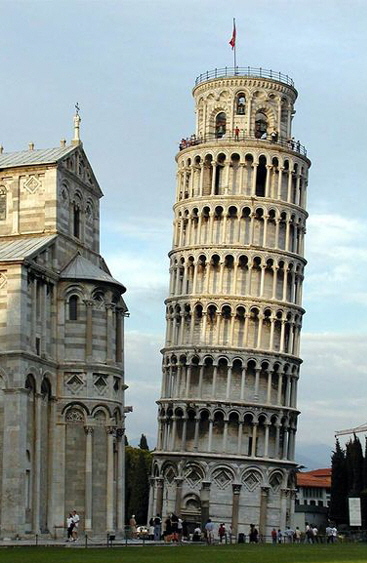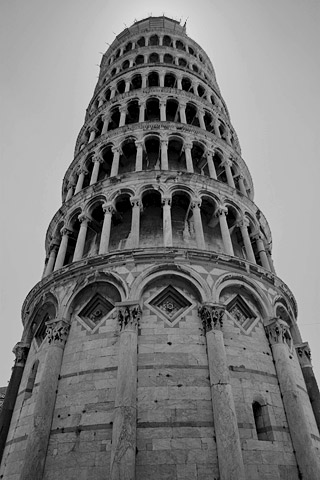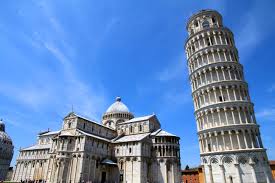 The Leaning Tower of Pisa (Italian: Torre pendente di Pisa or simply La Torre di Pisa) is the campanile, or bell tower, of the Italian city of Pisa’s cathedral.
The Leaning Tower of Pisa (Italian: Torre pendente di Pisa or simply La Torre di Pisa) is the campanile, or bell tower, of the Italian city of Pisa’s cathedral.
The tower was intended to stand vertically, to serve as a bell tower, but began leaning soon after construction started in August of 1173. It is situated behind the Cathedral and it is the third structure in Pisa’s Campo dei Miracoli (field of Miracles).
The height of the tower is 55.86 m from the ground on the lowest side and 56.70 m on the highest side. The width of the walls at the base is 4.09 m and at the top 2.48 m. Its weight is estimated at 14,500 tonnes. The tower has 294 steps.
The construction of the Tower of Pisa was performed in three stages over a period of about 200 years. Construction of the first floor of the white marble campanile began on August 9, 1173, a period of military success and prosperity. This first floor is surrounded by pillars with classical capitals, leaning against blind arches.
There is controversy about the identity of the architect of the Leaning Tower of Pisa. For many years the design was attributed to Guglielmo and Bonanno Pisano, a well known twelfth century resident artist of Pisa, famous for his bronze casting,
particularly in the Pisa Duomo. Bonanno Pisano left Pisa in 1185 to Monreale, Sicily, only to come back and die in his home town. His sarcophagus at the foot of the tower was discovered in 1820.
After the third floor was built in 1178, the tower acquired a lean, due to a mere three-meter foundation in weak, unstable subsoil. The design of this tower was flawed from the beginning. Construction was halted for almost 100 years because the Pisans were almost continually engaged in battles with Genoa, Lucca and Florence. This allowed for the underlying soil to settle, otherwise the tower would almost certainly have toppled. In 1198 some clocks were temporarily installed on the unfinished construction.
In 1272 construction was resumed by the Giovanni di Simone, architect of the Camposanto. Another four floors were built at an angle to compensate for the tilt. Construction again stopped in 1284, when the Pisans were defeated by the Genoans in the battle of Meloria.
 Only in 1372 was the last floor, the bell-chamber, built by Tommasso di Andrea Pisano and bells installed.
Only in 1372 was the last floor, the bell-chamber, built by Tommasso di Andrea Pisano and bells installed.
He succeeded in harmonizing the Gothic elements of the bell-chamber with the Romanesque style of the tower. There are seven bells, one for each note of the musical scale. The largest one was installed in 1655.
Galileo Galilei is said to have dropped two cannon balls of different masses from this tower to demonstrate that their descending speed was independent of their mass. This story, though reported by Galileo’s own student, is widely considered to be a myth.
In 1838 the architect Alessandro Della Gherardesca excavated a walkway around the tower to make the base of the tower visible again. This caused a flooding of the base and again an increase in the inclination.
Benito Mussolini ordered the tower be returned to a vertical position, so concrete was poured into its foundation. The results were unexpected and sank the tower further into the soft soil.
During World War II, the U.S. army destroyed nearly all towers in Pisa due to the potential threat from snipers. The Leaning Tower was scheduled to be blown up as well; a last-minute order to retreat prevented the destruction.
On February 27, 1964, the government of Italy requested aid in preventing the tower from toppling. A multinational task force of engineers, mathematicians and historians was assigned and met on the Azores islands to discuss stabilization methods. After over two decades of work on the subject, the tower was closed to the public in January 1990. In the time that the tower was closed the bells were removed to relieve some weight and cables were cinched around the third level and anchored several hundred meters away. Apartments and houses in the path of the tower were vacated for safety concerns. After a decade of corrective reconstruction and stabilization efforts the tower was reopened to the public on December 15, 2001. Many methods were proposed to stabilize the tower including the addition of 800 metric tons of lead counterweights to the raised end of the base. The final solution to correcting the lean was to remove 38 m³ of soil from underneath the raised end. The tower has been declared stable for at least another 300 years.
Technical information
 Geographic coordinates: 43.7231° N 10.3964° E
Geographic coordinates: 43.7231° N 10.3964° E- Elevation of Piazza dei Miracoli: about 2 metres (6 feet, DMS)
- Height: 55.863 metres (183 ft 3 in), 8 stories
- Outer diameter of base: 15.484 m
- Inner diameter of base: 7.368 m
- Weight: 14,700 tonnes
- Thickness of walls at the base: 8 ft (2.4 m)
- Direction of lean: 1173-1250 north, 1272-1997 south
- Total number of bells: 7, tuned to musical scale, clockwise
- 1st bell: L’assunta, cast in 1654 by Giovanni Pietro Orlandi, weight 3,620 kg (7,981 lb)
- 2nd bell: il Crocifisso, cast in 1572 by Vincenzo Possenti, weight 2,462 kg (5,428 lb)
- 3rd bell: San Ranieri, cast in 1719-21 by Giovanni Andrea Moreni, weight 1,448 kg (3,192 lb)
- 4th bell: La Terza (1st small one), cast in 1473, weight 300 kg (661 lb)
- 5th bell: La Pasquereccia, cast in 1262 by Lotteringo, weight 1,014 kg (2,235 lb)
- 6th bell: il Vespruccio (2nd small one), cast in the fourteenth century and again in 1501 by Nicola di Jacopo, weight 1,000 kg (2,205 lb)
- 7th bell: Del Pozzetto, cast in 1606, weight 652 kg (1,437 lb)
- Steps to bell tower: 294
